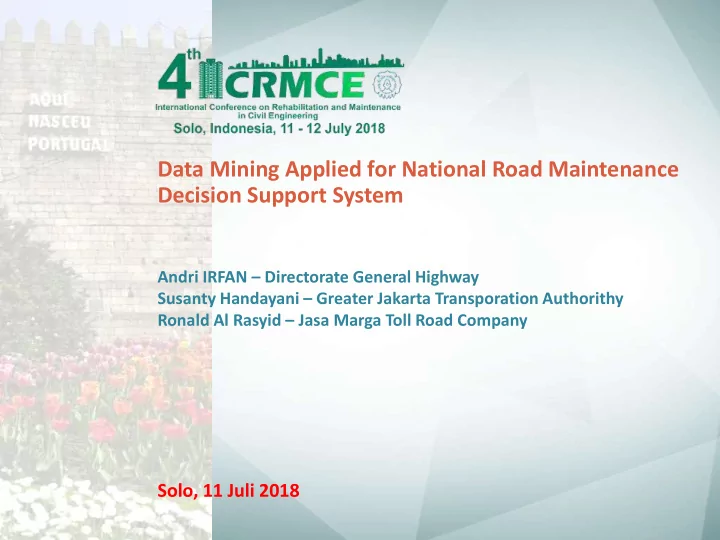

Data Mining Applied for National Road Maintenance Decision Support System Andri IRFAN – Directorate General Highway Susanty Handayani – Greater Jakarta Transporation Authorithy Ronald Al Rasyid – Jasa Marga Toll Road Company Solo, 11 Juli 2018
Contents Introduction Methodology Data Mining Pavement Maintenance Optimization DSS - Concept Conclusion Reference
Background Relevance of Sustainable Road Assets Maintenance ▪ Improvement of the roads service level ▪ Minimization of administration and user costs ▪ Reduction of environmental impacts; less resources consumption; less energy) ▪ Improvement of peoples’ quality of life (peoples’ health) An integrated approach of plan, design, construction and maintenance of all road assets: essential to achieve main objectives . Baasic Advance Intermediate • Function • Safety • Function • Non Geometric • Comfort • Structural • Smart • Sustainability
Background Infrastructures Maintenance Optimization Smart and Sustainable Mobility Smart and Sustainable Cities *) source : Pereira-CTAC
Background Physical Gap
Concept Pavement Management Systems (PMS) Project level Network level • Detailed engineering 2030 2025 O3 decisions 2018 2025 M&R O2 • Immediate consequences 2020 2017 O1 2016 S1 S4 S2 S3 Km Main Components Differences among PMSs ▪ ▪ Geographical Information System Objectives ▪ ▪ Database Performance indicators ▪ ▪ Performance prediction models Approach to the problem ▪ ▪ Decision support system Mathematical Formulation *) source : Pereira-CTAC
Problem Statement How to develop decision support system for pavement maintenance optimization? Objective Develop DSS pavement maintenance optimization concept based on GIS
Literature Map Genetic Algorithmr Programming Serviceability Indicator Fuzzy Logic Ferreira et al., 2002) · Moazamil (2011) Gedafa (2006) (ElHadidy et al., 2014) · Bennet C. R. · Ruotoistenmaki & Seppala 2007 Rating - AHP Moazami et al (2011) Maintenance Variance Modern Optimization MOPSO co-location-based decision tree Chou & Son Le (2011) Zhou & Wang (2011) Markov Transition Bako A. I & Horvatg Z. (2010) Jha M K & Abdullah J (2006) Life Cycle Cost Analysis Goh et all (2010) Monitoring & Controling Decision Support Model Non-parametric estimation Risk-Based IIRMS & HDM Fini et al (2011) Sayedshohadaei et al (2010) Bako. (2006) Applying AHP-Based Web-Based Budgeting & Financial Database Chou Jui-Sheng (2008) Chou Jui-Sheng (2008) GIS Pantha et al (2009) Planning Stage/Phase Business Process Irfan et al (2010) Bennet C. R. (2011)
Frame Work
Flow Chart
Method Decision Support System-Optimization Objective: generate several possible decision scenarios with the corresponding information that may help and support the decision maker choices Qualitative Methods Mathematical programing • Analytic Hierarchy Process • Linear • Fuzzy set theory • Non-linear • Decision-trees • Geometric • Integer Evolutionary Algorithms • Dynamic • Genetic algorithms • Stochastic • Artificial neural networks • Pattern search
Tools of Research Objection Model Tools Predict the IRI & Pavement Artificial Intelligence & Data R-Miner from R Tool Distress Mining Optimization Pavement Genetic Algorithm R-GA from R Tool Maintenance DSS-Concept Spatial Decision Model QGis Lisboa 1.8.0 From Quantum GIS
Data Source No of Model Development No ID Province Calibration Validation Optimization GIS Segment 1 A-JI Banten 45 √ 2 B-JI Jakarta 13 √ 3 C-JI West Java 259 √ √ √ 4 D-JI Central of Java 237 √ 5 E-JI Yogyakarta 36 √ 6 F-JI East Java 381 √
REC & VEC Curve Model Hyper-parameters Time (s) MR - 3.21 ± 0.03 𝜗 = 0.07 ± 0.01 and 𝛿 = 0.05 ± 0.00 SVM 117.02 ± 0.67 ANN H = 3 ± 1 102.37 ± 0.16
Sensitive Analysis
Case Study
Post Optimization Result IRI Predicted post Treatment Maintenance Scenario Sensitive Analysis
Map Concept The five basic map layers below are used in the GIS module ▪ detailed project-level results ANALYSIS RESULTS ▪ project ratings ▪ treatment methods and costs, ▪ AADT, and ▪ spatial location information (such as SegmentNo, NetworkNo, ProvinceNo, Sta. From and Sta. To, District) STATEROUTE Based on IIRMS concept (the complete information on state highway routes in Java Island) DISTRICT The detailed district information of Java Island PROVINCE IIRMS Province boundary information NETWORK Network boundary information
AddRelate Concept The AddRelate method uses this common field to create a join between the map layer and the results table and creates a new record-set, which contains all the records (6 java island province)
GIS Base-Map These five basic map layers include most of the information generated from the maintenance model results that can be displayed on GIS maps
Interface-Interactive Interactive Map-based Multi-year What-if Pavement Scenario Analysis Year n Year n+1 Year n+2
Main Result DM techniques , particularly and Artificial Neural Network (ANN) and Support Vector Machine (SVM) algorithms, proved to be powerful tools for explore pavement deterioration model. Indeed, these tools were able to learn with high accuracy the complex relationships between IRI and their contributing factors. SVM achieved a performance higher than 0.91, using R 2 as a performance indicator. The Genetic Algorithm Approach method, by taking advantages mathematical programming, offers a systematic, easy-to-use approach to the pavement maintenance optimization. Although only budget constraint is considered, other constraints could be easily added to the formulation. GIS technology is fully utilized in the decision support system for pavement maintenance. The GIS technology integrates graphical information in the GIS maps and the pavement performance model results obtained from the segment-level and the network-level seamlessly
Thank You Obrigado
Recommend
More recommend